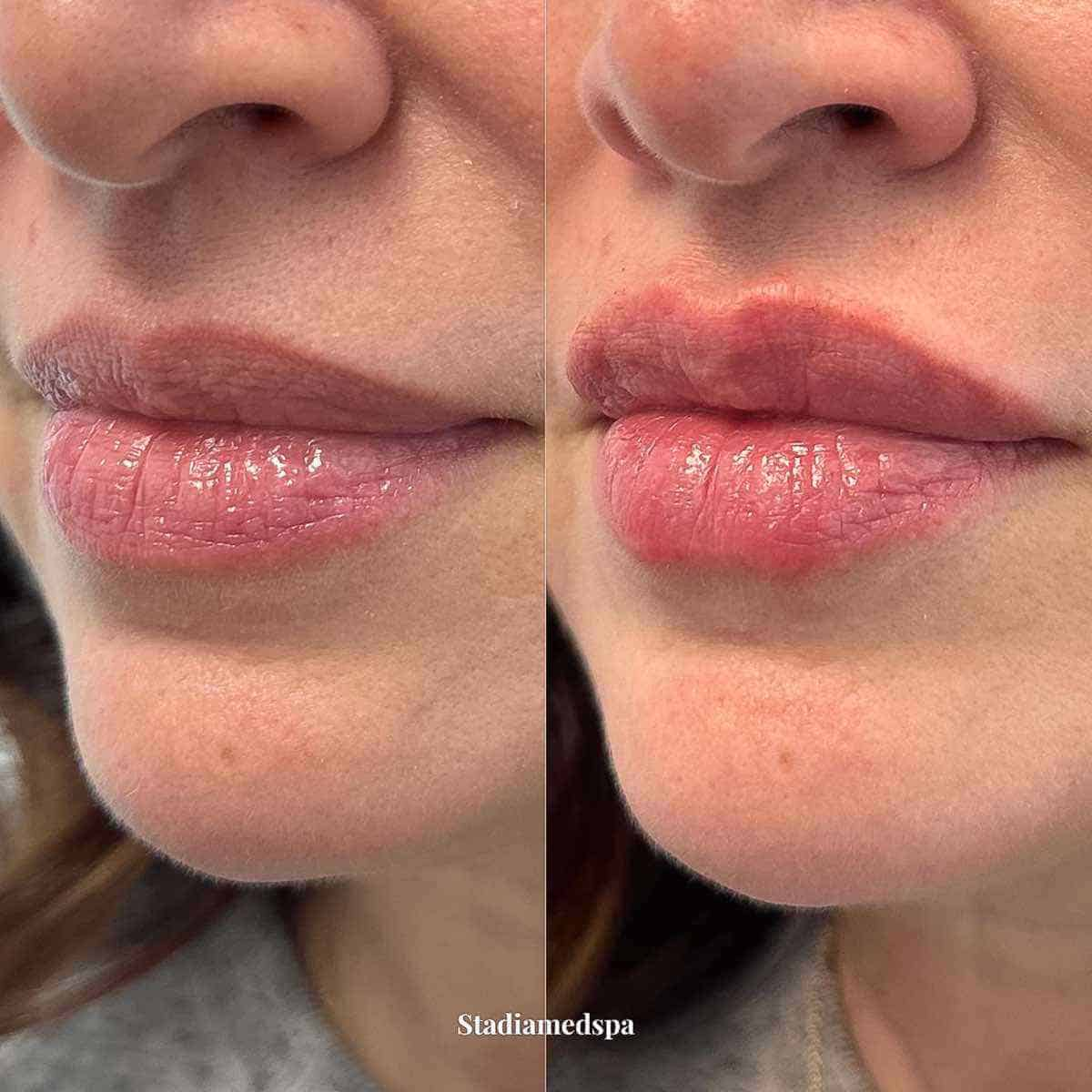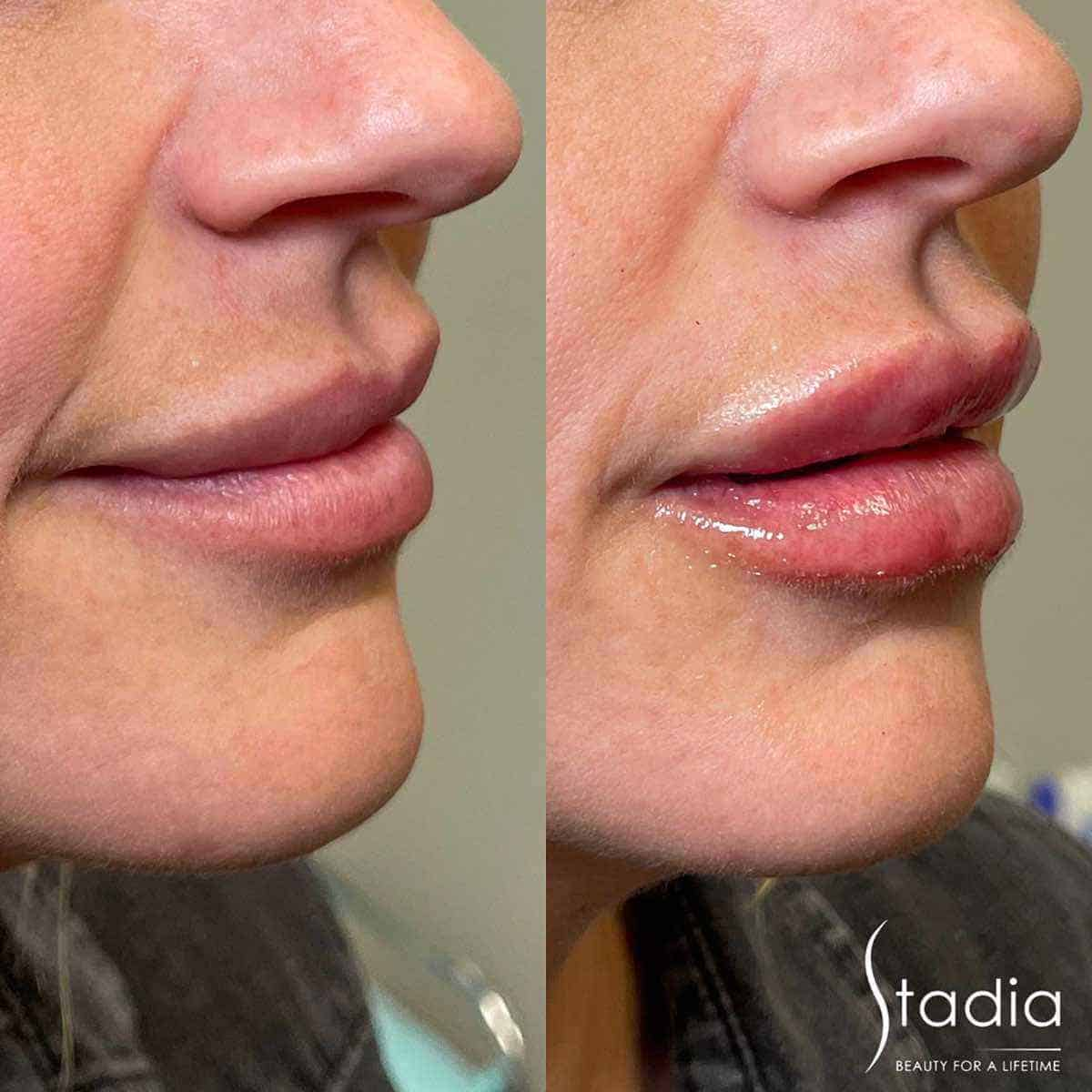In the last 10 years or so, dermal fillers have transformed the world of cosmetic injectables. Celebrities like Kylie Jenner made fillers popular, but these days everyone from your next-door neighbor to your mom has tried (or thought about trying) fillers for themselves.
Newcomers to fillers are always curious – are dermal fillers permanent?
Fillers filled the gap (pun intended) between Botox and plastic surgery. They last longer than Botox but are less permanent than time under the knife.
On average, dermal fillers last between one to five years. At Stadia Med Spa, we find that many people choose fillers because they don’t last forever. The results fade over time and allow you to adjust your treatment every couple of years based on how your face ages.
Keep reading if you are curious to learn more about how long dermal fillers last, including a look into how your body breaks down fillers and how you can make your fillers last.
Fillers – also called cosmetic injectables, soft tissue fillers, lip and facial fillers, or wrinkle fillers – are injectable substances that help shape the face. They smooth fine lines and wrinkles and add structure to your facial features. The “non-surgical nose job” is completed with fillers – a procedure that completely changes your nose shape and profile.
Dermal fillers contain a variety of substances, both natural and synthetic. These may include:
Dermal fillers are primarily made of a naturally-occurring substance called hyaluronic acid. Hyaluronic acid is a sugar made by the body that can be found in your fluids, tissues, and bones. Your body is constantly breaking down hyaluronic acid. So, over time, your body also breaks down the hyaluronic acid in fillers.
Most of the hyaluronic acid found in fillers is synthetic, meaning it was manufactured in a lab. But your body still recognizes fillers as a familiar substance, which helps to reduce side effects and risks.
Because the goal is to create lasting results, most fillers also contain other substances. Different fillers have different substances based on what they are designed to treat.
Polymethyl methacrylate is a longer-lasting filler, less biodegradable than hyaluronic acid.
Calcium hydroxylapatite is another naturally-occurring substance that is found in your bones.
Poly-L-lactic acid is a synthetic substance that helps your skin produce more collagen. More collagen means more elastic and firm-looking skin.
Autologous fat is fat transferred from another part of your body. Some fillers incorporate body fat to increase volume.
If you’re unsure which type of filler would work best for you, Stadia Med Spa offers a free consultation. You can ask any questions, address concerns about the procedure, and discuss the best option for your needs!
The body breaks down dermal fillers slowly. Your immune system produces hyaluronidase, a substance designed to dissolve hyaluronic acid. The natural hyaluronic acid in your body doesn’t usually last more than 36 hours.
The hyaluronic acid in fillers is stabilized in a process called cross-linking. The chains of hyaluronic acid are connected so that they aren’t immediately transported out of the body. Over time, the body breaks these connected chains and the hyaluronic acid is removed by your natural disposal systems.
Your metabolism will dictate how fast your body breaks down your fillers. People with a faster metabolism will see filler results fade more quickly than those with a slow metabolism. Since the metabolism is affected by many factors – including age, hormone function, gender, and fitness level – it can be hard to predict how long fillers will last.


If you were wondering – are dermal fillers permanent? – the answer is probably not. Even permanent fillers are broken down by the body with enough time.
Here is a look at how long each type of filler may last – from temporary fillers to “permanent” ones.
Temporary fillers last between six months and a year. They are thinner and usually made primarily of hyaluronic acid, so your body breaks them down fairly quickly. Temporary fillers are used for moderate to severe wrinkles and to restore volume to your face. Lip fillers are temporary fillers that increase the volume of your lips.
Semi-permanent fillers typically last between two and five years. They are more viscous and, therefore, harder for your body to break down. Semi-permanent fillers are also used to treat moderate to severe wrinkles and restore volume. They can also augment the cheekbones, chin, and jawline to reshape your face and reduce any facial sagging.
Permanent fillers last the longest, but they aren’t permanent. They aren’t biodegradable, so the body takes longer to break them down. Permanent fillers are usually injected into areas with thick skin, like the nasolabial folds.
You probably have very little control over the speed of your metabolism. You can’t slow it down to make your fillers last longer. But you can take care of your fillers to prolong their breakdown.
One of the simplest ways to take care of your fillers is to drink lots of water. Fillers – and especially fillers that contain hyaluronic acid – love water. Hydrate regularly and use moisturizer in the treatment area to prolong results from your dermal fillers.
Cosmetic fillers last the longest when you have a regular skincare routine. Use products that protect your skin from free radicals and that promote collagen production. You should also protect your skin from the sun with high-quality sunscreen.
Your lifestyle also plays an important role in health and the longevity of your dermal fillers. A healthy diet supports healthy skin, as does sleep and managing stress.
If you are interested in trying dermal fillers, Stadia Med Spa offers a variety of filler options. Start with a free consultation to discuss which type of filler best suits your needs. Dermal fillers can be used to increase the volume of your lips, reduce facial sagging, smooth fine lines and wrinkles, and restore volume to your face.
Contact us to schedule a free consultation for dermal fillers today!
Call 210-881-6270 today!